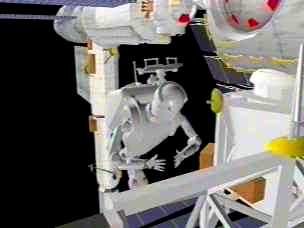The idea is taken from the Star Trek series

A round and small robot, which serves as a guard and personal assistant, is expected to be sent in about three years to assist the work of the astronauts on the International Space Station. The robot is currently in advanced stages of development, and its engineers say it will be able to hover around the astronauts, assist them with their daily tasks and monitor the station's condition.
The robot is called a "personal satellite assistant", and its dimensions are slightly larger than a tennis ball. "We are developing a smart robot that can serve both the crew in space and the support crew on the ground as an additional pair of eyes, ears and nose," explains Yuri Gavdiak, an engineer at the NASA Research Center in California who heads the project.
The electronic friend is equipped with cameras, speakers, microphones and a variety of sensors. It will float alongside the astronaut in zero-gravity space, and respond to his voice commands. Motion and location detectors are also embedded in the robot, to prevent it from bumping into objects or getting lost. It is equipped with six propellers, and a flat video monitor for displaying data.
When an astronaut works on an experiment in space and both hands are occupied, for example, the robot will be able to transmit the images to the support team on Earth. The device can also patrol the corridors of the space station, checking for leaks, smoke or bacterial growth. It will be able to remind the astronauts what their next task is on the daily to-do list, and even remind them to send a loving message on the birthday of their loved ones left on Earth.
Gaudiak says that the idea for the development of the robot came from a scene from "Star Wars". "In one of the scenes in the film, the characters used a robotic object - a speeding bullet - to work with their lightsabers."
Since it is impossible to cram into the small ball all the computing power necessary to perform the tasks that the robots are expected to do, Tafoal will be based on a wireless communication network, which will operate from a central mother station. The mother station will have powerful computers that will analyze the data coming from the sensors, recognize and process sound, transmit the broadcasts and monitor the robots.
Gaudiak estimates that within two years the robot will be ready for launch. "We hope to launch a personal satellite assistant on a space shuttle within about two years, and within three years to the International Space Station," said Gowdiak. 17 countries are partners in building the space station. The cost of its construction is estimated at 60 billion dollars, and up to seven astronauts will be able to stay in it at the same time. The personal assistant engineers want to send at least six assistants to the station.
The helper robots may also cooperate in space with other robots - for example with a camera the size of a volleyball controlled by remote control, which was first tried in 97 on the space shuttle Columbia. In the experiment, the camera hovered outside the spacecraft for more than an hour to show that it could be used, instead of a person, to check what was going on outside the spacecraft.
Gaudiak hopes that in the future each astronaut on the station will have a personal friend that will be adjusted to their schedule. {Appeared in Haaretz newspaper, 5/10/1999{
